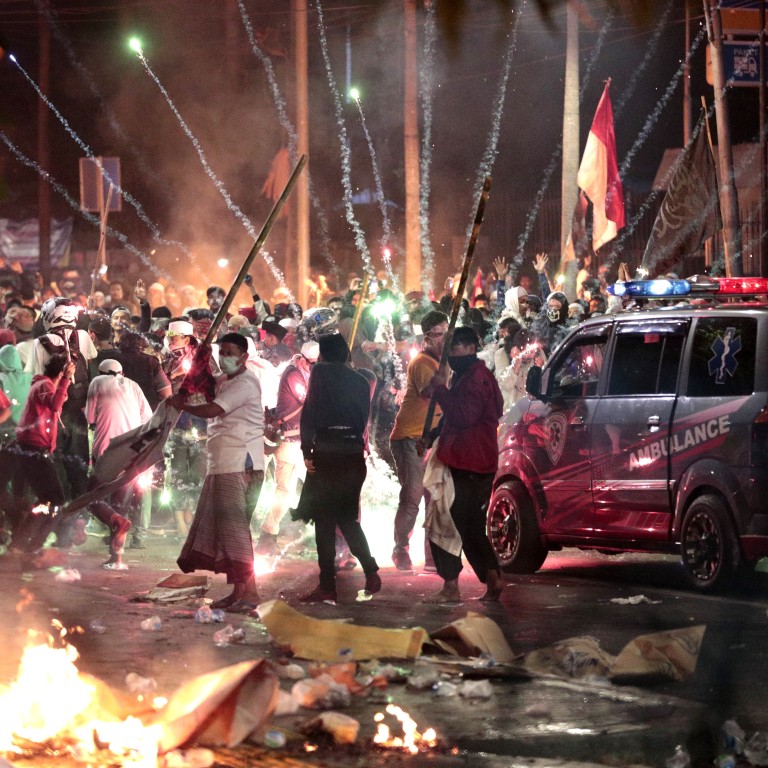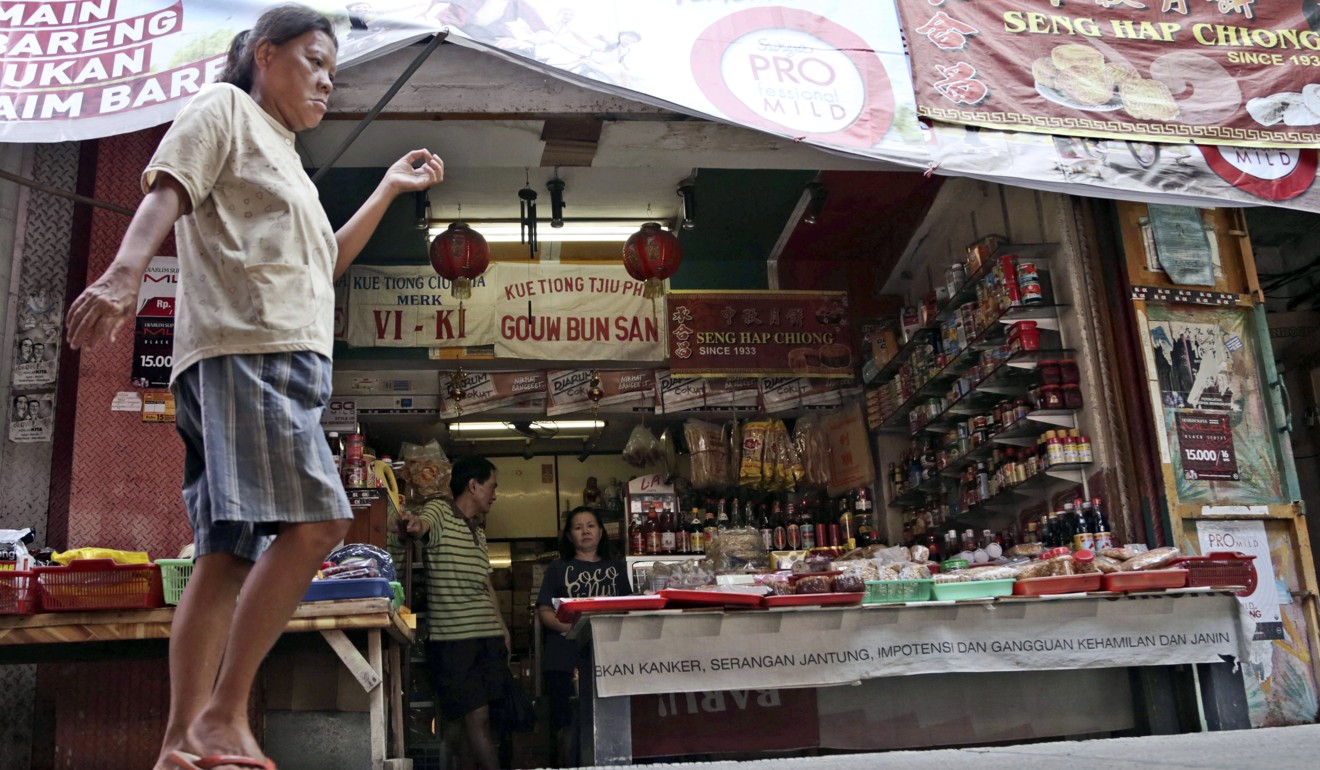
Indonesia’s election riots offer a lesson on the perils of fake news
- The violence in May over President Joko Widodo’s victory was the first time among the world’s democracies that online disinformation led to a poll-related riot
- Anti-Chinese conspiracy theories also spiralled out of control, with some Indonesians believing People’s Liberation Army troops were on the streets of Jakarta
Many involved in the Jakarta street violence were motivated by misleading or false information. Militant oppositionists were mobilised by a cascade of fake news that culminated in a belief that their community was under attack. With the mainstream media largely sympathetic to the government, those provoking the unrest relied on social media platforms – notably encrypted chat applications such as WhatsApp and Telegram.

FROM PROTESTS TO RIOTS
Acting on the belief that the election had been stolen, thousands of protesters descended on the office of the Elections Supervisory Agency on May 21. They demanded the agency disqualify Jokowi and running mate Ma’ruf Amin for “structured, systematic, and massive” electoral fraud. After nightfall, smaller groups began to throw rocks and petrol bombs at police. Skirmishes broke out in the Tanah Abang area of central Jakarta near the headquarters of the Islamic Defenders Front, the lead organisation in the protests. A violent clash occurred and a nearby police dormitory came under attack. By the end of May 23, more than 400 people had been arrested in the worst street violence in Jakarta since the fall of president Suharto in 1998.
Tensions among Indonesia’s security forces simmer beneath surface after poll riots
CHINESE SCARE STORIES
How peaceful protests against Widodo’s re-election descended into violent chaos
Out of context, reports of Chinese troops on the streets of Jakarta might sound implausible. But within the militant opposition online echo chamber, they were the logical extension of months, if not years, of conspiracy theories on the theme of Chinese neo-imperialism. Other messages alleged Chinese troops had infiltrated police units deployed to counter the rioters.
“I thought only foreign workers were being brought from China. In fact, [Chinese] are also being brought to kill the people,” one Telegram user wrote.

The soldiers hoax was disseminated and discussed incessantly on Telegram chat groups. Images of masked Indonesian police were presented as evidence of Chinese troops being deployed. In an indication of just how seriously the Indonesian police responded to this hoax, on May 24, at the national police headquarters in Jakarta, the public relations unit held a press conference in which three officers whose images had been used in the hoax were presented to the public.
In a dramatic scene made for live television, the officers unmasked themselves before the cameras and gave their names and birthplaces to prove they were Indonesian citizens.
How Indonesia’s poll riot was brought under control – and one man is taking credit
‘MOSQUE ATTACK’
Fake news was also spread that claimed a historic mosque not far from the protest site outside the Elections Supervisory Agency had been attacked by police. The Al-Makmur mosque was one of dozens in the area at which protesters from outside Jakarta had stayed overnight. One version of the story claimed police involved in the “attack” were ethnic Chinese.
The origins of this hoax can be traced to the night of May 21, when violence first broke out in front of the agency’s building. As police forced protesters back towards the central Jakarta suburb of Tanah Abang, their rubber bullets and tear gas came in close proximity to the mosque, which is located along the route.
Panic was sparked among protesters who feared the mosque was being targeted. In a brief, shaky video circulated on messaging apps not long after the incident, titled “Tanah Abang Mosque Situation”, an unidentified voice says: “Al-Makmur mosque in Tanah Abang is being fired on by inhumane police, we are being fired on here.”

Jejak News Agency, a recently emerged jihadist Telegram account styled as a newswire, also reported on the “mosque attack”, spreading the disinformation across the Indonesian jihadist community.
A video circulated on the night of May 21 further spread the hoax by using prominent local Muslim figures to add credibility.
In fact, the mosque suffered no damage and the reports of an attack were denied by police.
Chinese Indonesians fear attacks as anti-China hoaxes spread on social media
UNEARTHING THE TRUTH
Following the riots, police investigators and journalists focused on uncovering the premeditated and coordinated aspects of the violence. There is some evidence that a degree of preparation and coordination by elite actors and agent provocateurs helped to turn a peaceful protest into a street battle. But promises to reveal the “puppet master” of the riots have fallen through.
Meanwhile, it is clear that a cocktail of false information and grievances created a fertile environment for political violence. Individuals who took part included Islamic Defenders Front members, an assortment of their sympathisers, mosque youth, street toughs, locals “defending” their neighbourhood, and youths from West Java and other regions who had been sent to Jakarta by their religious teachers to join the protest. Others may have been bystanders reacting to police raids.

Sapto Putra Permana, 22, said he had felt provoked after watching an online video, and decided to go to the streets and fight the police without checking the accuracy of the clip.
“I couldn’t accept that my religion was being meddled with,” said the resident of Radio Dalam in South Jakarta.
Sapto was hospitalised after being shot by police in the leg with a rubber bullet.
Indonesia has given the world a salutary example of how ethnic and religiously tinged disinformation can spiral out of control on social media, intensifying post-election tensions into violent conflict and creating a sense of political crisis. The leveraging of social media disinformation to target core institutions of democracy, such as election monitoring agencies and the electoral process itself, is a threat to democratic countries everywhere. ■
Quinton Temby is a visiting fellow in the Indonesia Studies Programme at the ISEAS-Yusof Ishak Institute in Singapore. This is an edited excerpt of an article titled Disinformation, Violence and Anti-Chinese Sentiment in Indonesia’s 2019 Elections, published in ISEAS Perspective No 67

